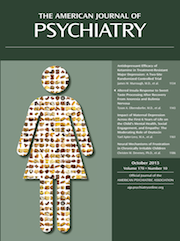Chronic Benign Neutropenia/Agranulocytosis Associated With Non-Clozapine Antipsychotics
To the Editor: Agranulocytosis (absolute neutrophil count, <500/μl) is a potentially life-threatening condition. Clozapine and other antipsychotics are associated with acute agranulocytosis (1). We report the case of a man with chronic and benign neutropenia/agranulocytosis associated with multiple non-clozapine antipsychotics (fluphenazine, olanzapine, flupenthixol, haloperidol, and paliperidone).
Case Report
“Mr. N,” a man in his mid-50s, was diagnosed with paranoid schizophrenia in his early 20s. He had never received clozapine, but he had been taking fluphenazine, 50 mg i.m every 2 weeks, for 20 years when he was initially noted neutropenic in 2003 (Figure 1). In 2004, the neutropenia worsened with the introduction of olanzapine, 10 mg/day, dropping to 500 neutrophils/μl. At this point, both antipsychotics were discontinued and he was started on haloperidol, 5 mg/day. In early 2006, he was switched to flupenthixol, 40 mg i.m every 2 weeks. Mr. N’s absolute neutrophil count dropped to 200/μl, and he was subsequently switched back to fluphenazine (range, 20–60 mg every 2 weeks) late in that same year. In fall 2012, he was admitted as a result of a psychosis exacerbation thought to be related to noncompliance of antipsychotic therapy. On admission, his absolute neutrophil count was noted as 2,100/μl, and this dropped to 400/μl after switching to paliperidone (156 mg every 4 weeks, maintenance dosage). Of note, this pattern had been documented on two prior admissions that were caused by noncompliance followed by acute psychotic exacerbations (Figure 1). The treatment plan included maintaining paliperidone at the lowest dosage possible that would prevent psychosis.

A bone marrow biopsy in February 2006, when Mr. N’s absolute neutrophil count was 300/μl, revealed normal cellularity on the three lines, with adequate white cell precursors and good white cell differentiation, indicating no bone marrow disorder. He was human leukocyte antigen (HLA) II genotyped, showing a DQB1*06 genotype (DRB1*15, DRB1*16, and DQB1*05 were all absent). Over 10 years of follow-up, Mr. N. has never presented with any infectious complication from low absolute neutrophil count or required treatment with granulocyte colony-stimulating factor.
Discussion
The presence of a normal bone marrow biopsy in Mr. N points to a peripheral mechanism of destruction of mature neutrophils. In addition, the patient’s HLA genotype is not associated with autoimmune agranulocytosis, and therefore the most plausible mechanism seems to be hapten mechanism, whereby binding of the drug to the membrane of granulocytes induces antibodies directed to the drug (hapten) (2). The most likely diagnosis is that of idiosyncratic drug-induced chronic benign neutropenia. In our patient, where discontinuation of the likely causative agent(s) of low absolute neutrophil count was not possible because of the extreme risk associated with discontinuation of antipsychotic therapy, a conservative course of action was decided. Lowest dosages of antipsychotics, the avoidance of drugs known to be associated with neutropenia, close and regular monitoring of WBC and absolute neutrophil count, consultation to rule out central or autoimmune mechanisms, and ongoing shared care with hematology were all essential components of excellent care in this complex clinical situation. This approach might be applicable in similar situations other clinicians may encounter.
1. : Systematic review: agranulocytosis induced by nonchemotherapy drugs. Ann Intern Med 2007; 146:657–665Crossref, Medline, Google Scholar
2. : Drug-induced agranulocytosis: review of possible mechanisms, and prospects for clozapine studies. Psychopharmacology (Berl) 1989; 99(suppl):S113–S117Crossref, Medline, Google Scholar



